|
- Catalog (in stock)
- Back-Catalog
- Mail Order
- Online Order
- Sounds
- Instruments
- Projects
- History Face
- ten years 87-97
- Review Face
- our friends
- Albis Face
- Albis - Photos
- Albis Work
- Links
- Home
- Contact
- Profil YouTube
- Overton Network
P & C December 1998
- Face Music / Albi
- last update 03-2016
|
Instruments:
 
aghas-khomys
|
- Khomys (string instument)
This is a two-string or three-string lute, related to the Altaian topshur, the Tuvan doshpulur and the Mongolian tovshuur. The Khakas people play two types of khomys: the aghas-khomys and the topchyl-khomys.
Both have a body and neck carved from cedar wood, but while the former has a sounding board from cedar wood, the body of the latter is covered with the skin of wild roe deer, domestic goat, or cattle. The traditional stringing is of twisted horsetail hair, and the strings are tuned a fourth or fifth apart; the three-string khomys is tuned a fourth plus a fifth apart.
"In Western Mongolia there is existent a legend on the development of the lute referring to a holy swan, which is why there is provided a swan head at the neck end.
Instrument makers also tell that the instrument is given its soul and spirit from nature, by lifting the lute up into the wind and waiting for it to start vibrating. The spirits of the mountain or of the wind will then have given the lute spirit and soul."

 – topchyl-khomys – topchyl-khomys
|
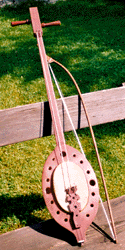  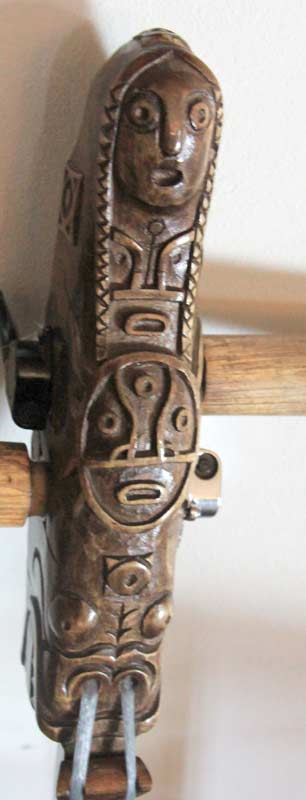 
|
- Yykh (string instrument)
This is a two-string fiddle of the Khakas people, related to the Altaian ikili, the Tuvan igil and the Mongolian ikil.
Its body is similar to the khomys but has a longer neck. The body, like that of the topchyl-khomys, is covered with the skin of wild roe deer, domestic goat or juvenile cattle. The strings are made from twisted horsetail hair and are tuned a fourth or fifth apart. It is played with a bow made of willow with horsetail hair stringing, and it is coated with larch or cedar wood resin.
. 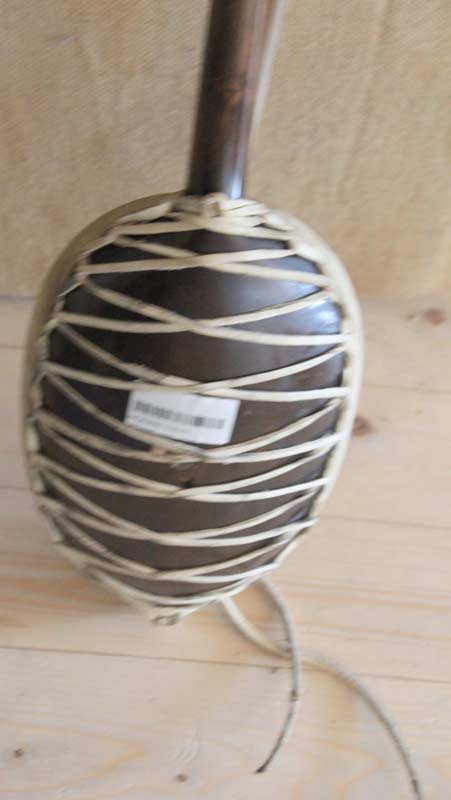
|
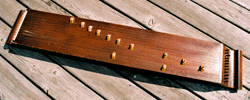
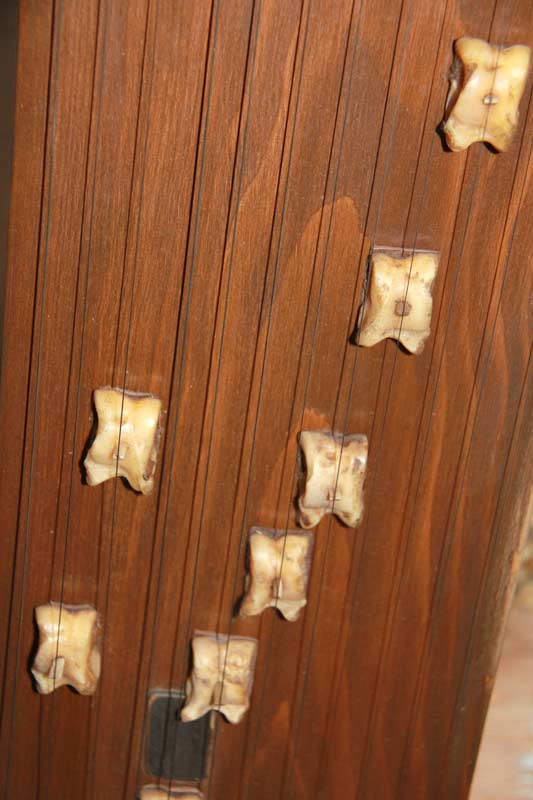
|
- Chatkhan or chadyghan (string instrument)
With six to fourteen strings plucked box zither of the Khakas people, distantly related to the Tuvan chadagan, Mongolian yatga, Japanese koto, Chinese quin and Korean kayagum.
The Khakas zither is a 1.5 metres long box from spruce wood, with each metal string running over an individual movable bridge made from sheep’s knucklebone. It is likely to originally have consisted of a short body (about 50 cm long) hollowed out from underneath like an upturned trough, with strings of horsetail hair.
However, in the 18th century it already broadly had its present shape: a long box of nailed boards with 6 or 7 metal strings. It has a rather smooth sound, ideal for performance in intimate company. The chatkhan is tuned in a pentatonic scale, with one or two strings tuned a fifth and/or octave below the lowest melody string, to obtain a drone. The strings are plucked and strummed to the right of the moveable bridges with the right hand to produce both melody and drone. The left hand is used to press particular strings to the left of the moveable bridge. In this way, diatonic melodies can be played, as well as the adorning gliding tones and vibratos so typical for the instrument.
The chatkhan (like the Khakas lutes) could hold a spirit, and therefore handling and playing was bound by taboos and rituals. Unlike the long zithers (yatga) of their southeastern neighbours, the Mongols, who mainly used the long zither at court and in monasteries since strings symbolised the twelve levels of the palace hierarchy, the chatkhan was used to accompany lyrical, historical and epic songs and heroic tales in intimate gatherings of common people, especially at weddings and nocturnal dead wakes.
The Khakas sacred heroic epics say: "We are all universal, since we participate in the creation of the world every year, every day and every moment". This goes also for their folklore, customs and traditions. Artistic creativity is interwoven with material production, the way of life and everyday relationships. In the traditional Khakass society every man and every woman can get the gift of creativity. A genre of oral folk creative work, known as the takhpakh (=improvised songs) was especially wide spread.
|
Women hold an important place in the Khakas society, which is reflected in many heroic poems and epics. Female warriors have been great heroes against external enemies. Women wear a "pogho", a female breast ornament made of cowry shells, pearl buttons and colourful beads sewn to leather or textile, and how they live is explained in one specific tale, where the rules are described in ornamental form. The poghos build a bridge between generations and function at the same time as a spiritual protective shield that protects female fertility and thus secures offspring (animist thinking) against external enemies.
|
 |

|

|
- Khobyrakh or Shoor (wind instrument)
Formerly an open end-blown flute similar to that used by the Bashkirs and the Caucasians. It was a 30 to 80 cm long, smooth, hollow pipe without finger holes, made of the stem of a large umbelliferous or willow plant. The Khaas tribe called it “khobyrakh” (lit. “hogweed”, a kind of umbelliferous), while the Saghai and Shor tribes called it “shoor” (like the Altaians).
Nowadays it has a small block with a slit at the top, six finger holes, and it is made of wood veneer (ash, mahogany and other species) or plastic.
The Altai people also know a wind instrument, they call “shagur“ and which is similar to the shoor and the khobyrakh. It has, however, holes at the side and is made from wood. Its length is 30-40 cm.
|

chervil

|
- Syylas (wind instrument)
An open end-blown flute similar to that used by the Bashkirs and the Caucasians. It is a 50-70 cm long hollow pipe with four finger holes to the front and one to the back. It is made from the stem of the big chevil (parasol-like plant, designation for big umbelliferous plants) or from wood. Today it is mostly made from plastic.
Melodies are created via airflow by covering or uncovering the lower end, using a finger. As such a traditionally produced instrument is unsuitable for transport, rather fragile and frail, this instrument is nowadays made from plastics. Today, it often has 3 and sometimes even 6 fingerholes.

chervil
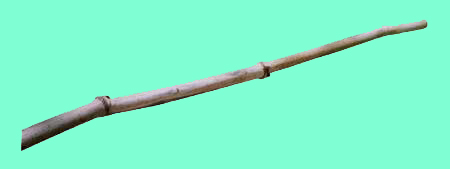
|
Among others, hunters used different types and sizes of wind instruments (flutes and whistles).
Among them, there are a straw whistle syghyrkhy (sîghîrtkhî), a smaller birch whistle sybyskhy (sîbîskhî) and the bigger, conical trumpet pyrghy (pîrghî) made of wooden. Tones are generated by means of sucking ("drawing in"). The pyrghy is frequently used as a signal horn in order to mark the beginning of a ritual during clan meetings or shaman sessions.
|
- Syghyrtkhy – straw whistle or bird's feather (wind instrument)
This is a small whistle made from a bird feather or straw.
|
|
|
- Sybyskhy (wind instrument)
This is a small whistle, a wind instrument used for coaxing wild deer and made of birch bark.
|
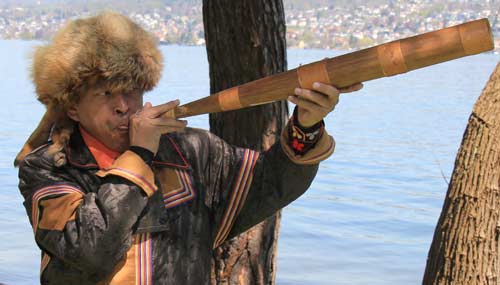
|
- Pyrghy (wind instrument)
A large, conical, sucked trumpet from wood is used to hunt large game (elk, Siberian deer and red deer).
It is made of two identical conical wooden halves, tied with strips of birch bark or willow. The tip is inserted into the corner of the mouth and air is sucked with force, which results in a sound like a deer’s call. Today it is used in addition as a signalling instrument to open community celebrations, clan meetings, and shamanic sessions.

- Amirgi-Manok – as it is called by the Altai people; this is a hunting horn having a long conical tube made of birch bark. It is carved of a Siberian pine into two halves that are tied together by birch bark. The same sound may, however, also be produced using a slightly conical cone made of any rigid material. This instrument is not used to produce melodies but rather to imitate animal sounds in order to attract these.
|
|
- Türlö – swirled (wind insturment)
This is a wind instrument swung around by hand to produce wind that makes the instrument sound.
|
|
- Shagy (wind instrument)
It is made of sheep’s knucklebone and used in order to attract sheep.
|
 |
- Timîr-khomys – jew's harp.
This is a small horseshoe-shaped instrument to which a stiff spring is attached. Today it is made of brass or steel (timîr-khomys literally means “iron utensil”) but in the past it was made of wood.
The player places the frame of the instrument with his left hand to his mouth, touching the front teeth, and taps the spring, which is called ‘tongue’, with his right hand. The instrument’s tongue acts as a vibrator, while the mouth cavity acts as a resonance chamber. The player can vary pitch and timbre by changing the shape of the mouth cavity, opening or closing the throat, and changing the attack on the instrument's tongue.
|

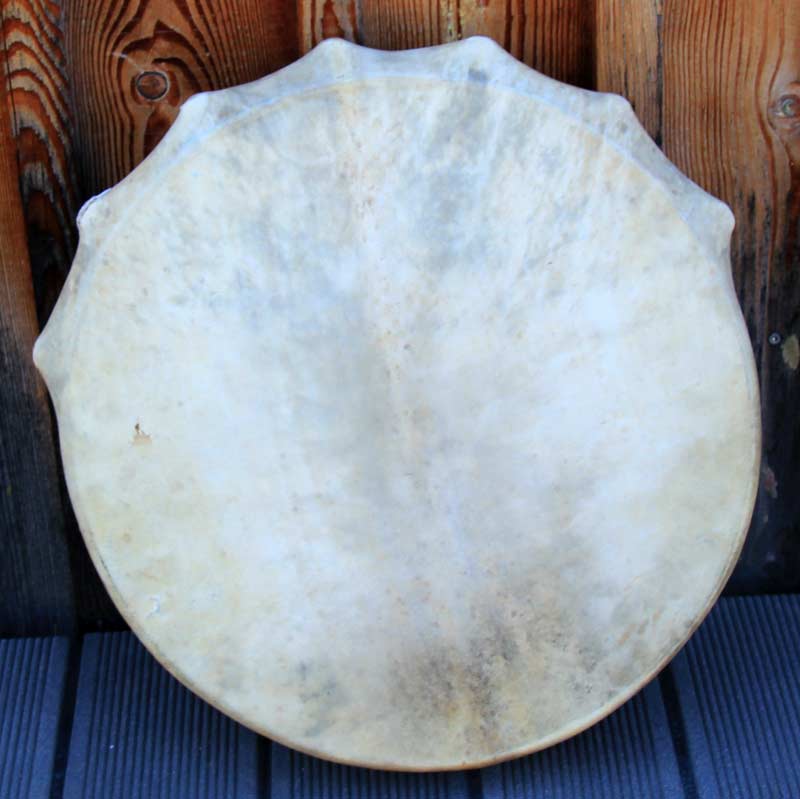
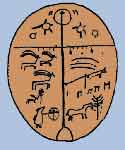
|
- Tüür - single-sided frame drum – shaman’s drum (tungur) – (percussion instrument)
The drum consists of a round wooden frame fixed inside with one vertical and one horizontal wooden stick and covered with the skin of a cloven-hoofed animal. Formerly it was only used as a ritual instrument by shamans (kham). Today it is also used as the main percussion instrument in music ensembles.
When used as a ritual instrument, drawings are made on the outer side of the drumhead, and coloured ribbons (chalama), metal bits and bells are attached to the horizontal stick inside.
- Orba – drum stick of wood and leather belonging to the tüür.
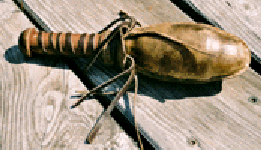
It is made of the urinary bladder of an animal filled with grain and has a handle.
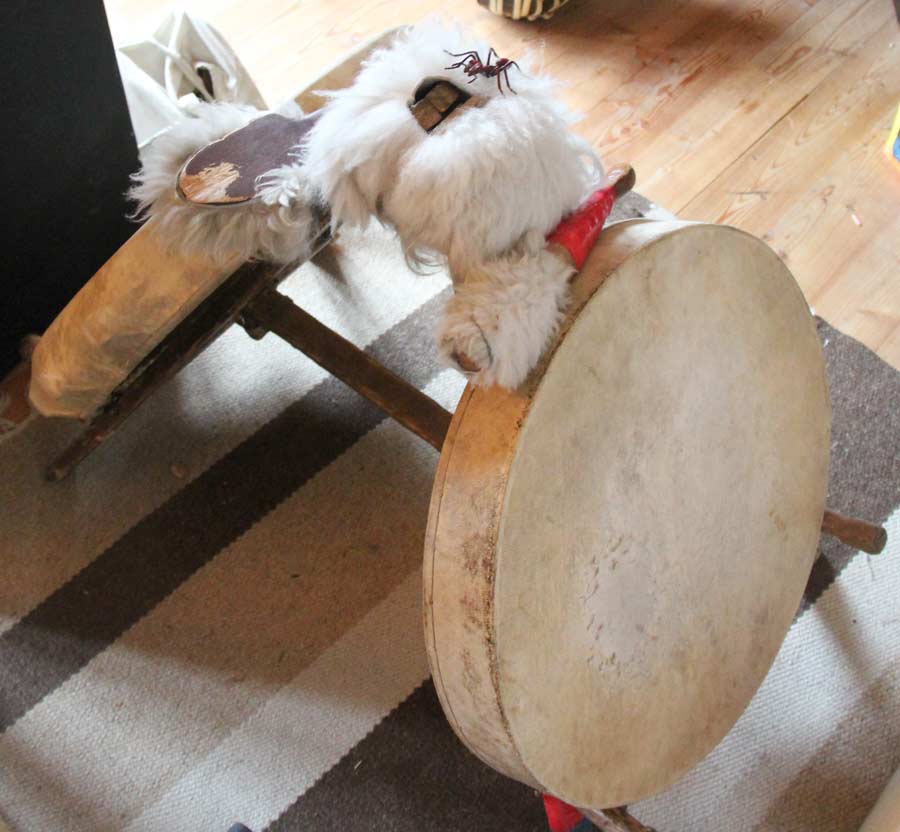 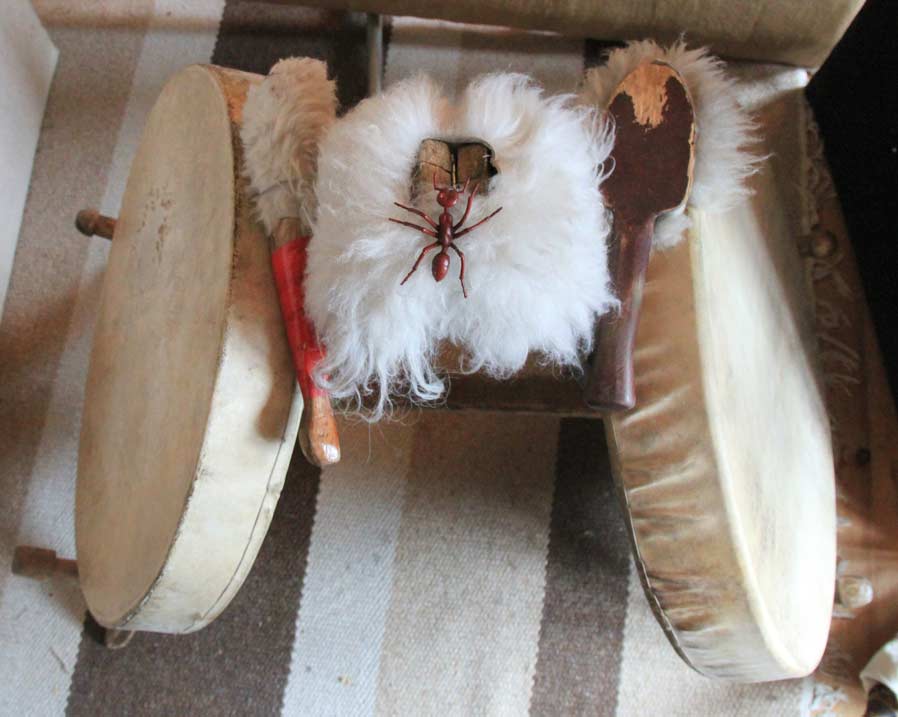
|

|
- Khongyros (percussion instrument)
Made of leather and filled with grain. |

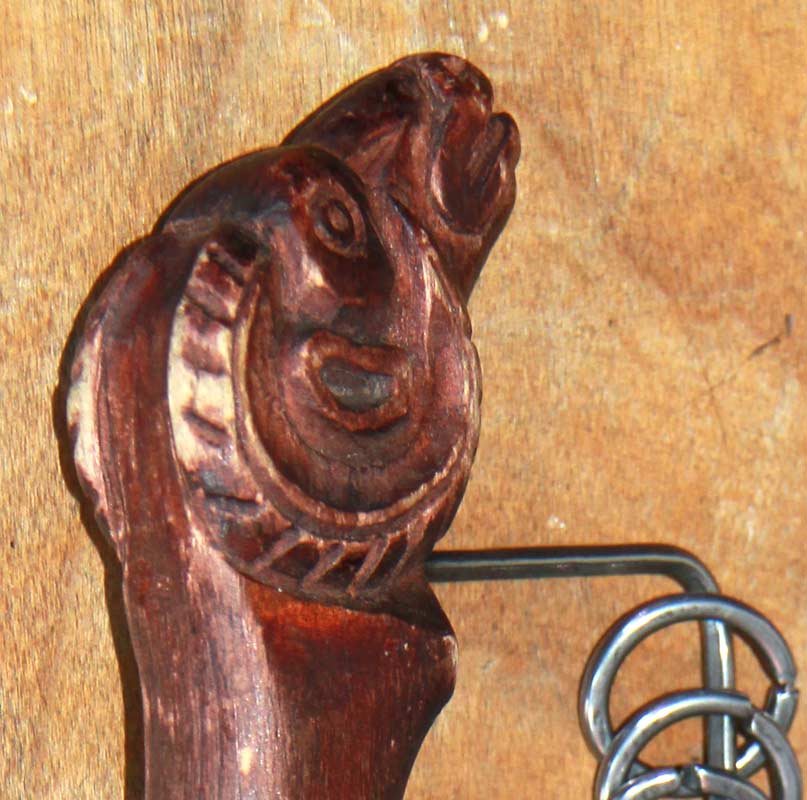
|
- Sangyros (percussion instrument)
Rattle with metal rings with a wooden handle shaped with the head of a horse head and ram. |

|
- Khazykhtar (percussion instrument)
Rattle of sheep knucklebones. |
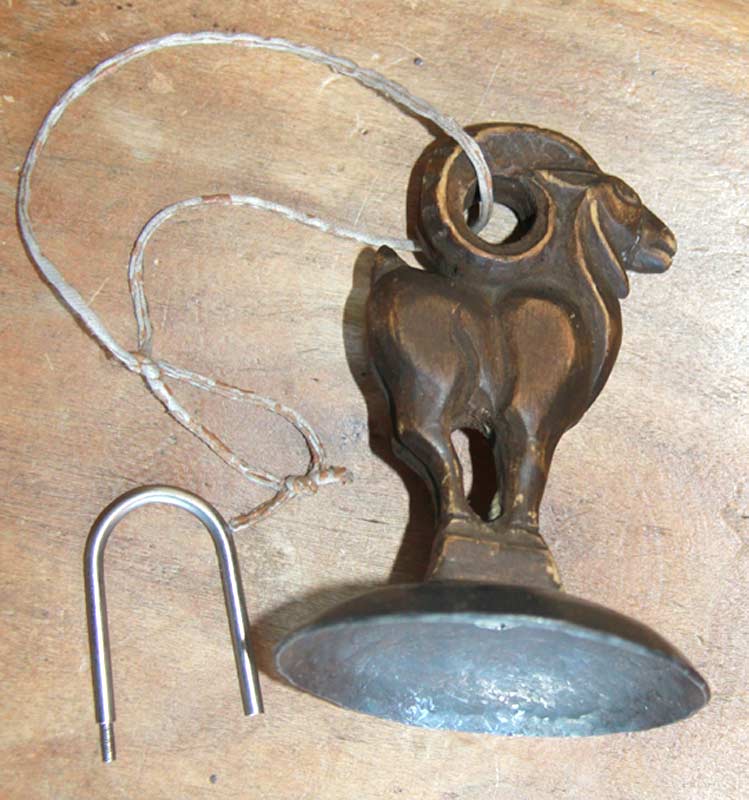
|
- Sang (percussion instrument)
Iron hand bell with a wooden handle shaped as a male ibex. |

|
- Müüs (percussion instrument)
Rattle made of a cow horn, filled with small stones and closed with leather. |
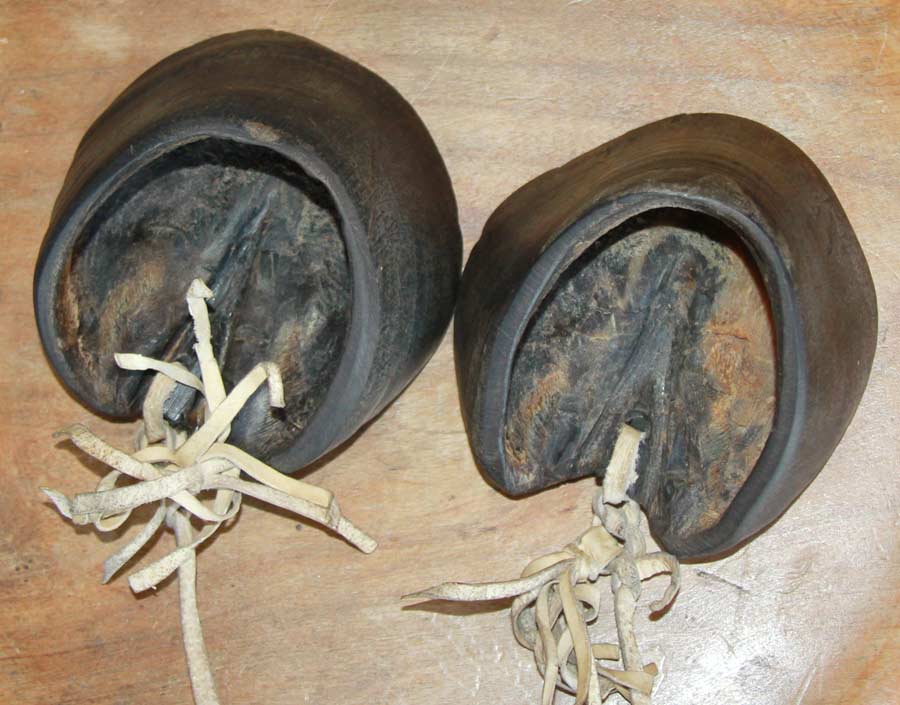
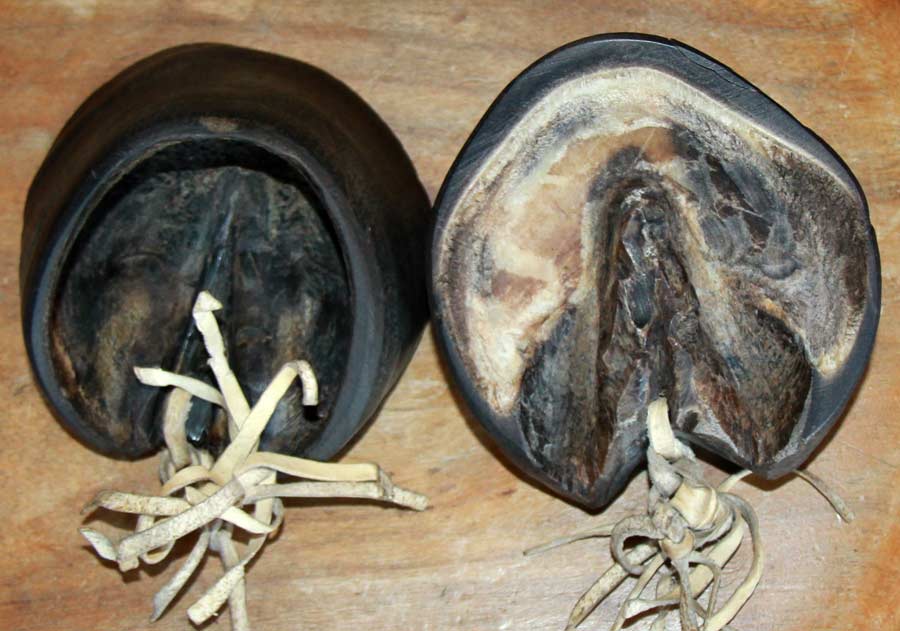
|
- Tuyghakh-tar - Paddock – hors's hoof (percussion instrument)
Horse hoove clapper. |
Revised by Hermelinde Steiner and Liesbet Nyssen 2013
back to Index Central Asia
PageTop

|
